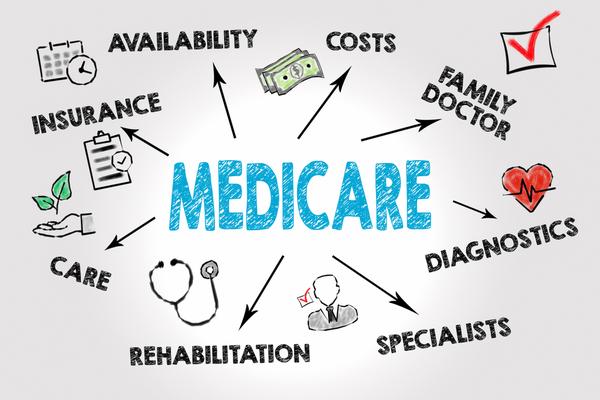Open Enrollment Starts October 15th: Additional Information for Medicare
Medicare open enrollment is just around the corner. The program’s annual enrollment period runs from October 15th through December 7th. [1] Medicare beneficiaries will have a chance to change plans or stick with their existing coverage. Because plan expenses and benefits change often, it is important to evaluate options each year.

In order to modify a health insurance plan, one should always compare the current Medicare plan to other available options. The consumer may also need to watch out for significant Medicare rule changes for 2020. There can be changes in the expansion of Medicare Advantage benefits, an increase in out-of-pocket drug price and an updated version of the Medicare Plan Finder. Medicare Plan Finder is a popular tool that allows people to compare Medicare plans online.
Written below is some of the basic information about Medicare that anyone should be aware of before signing up for Medicare or switching plans.
Am I Eligible for Medicare?
Generally, Medicare provides health insurance to Americans 65 and older as well as to people with disabilities. People with certain disorders including End Stage Renal failure (permanent kidney failure requiring dialysis or transplant) [2] and amyotrophic lateral sclerosis are also eligible. People age 65 or older who worked and paid Medicare taxes for at least 10 years are eligible for premium Part A.
How Does Medicare Coverage Work?
With Medicare, people have options in how they get their coverage. Once they enroll, they will need to decide how they can get Medicare coverage. There are four different parts each with different benefits. Just take a look at these Medicare plan options.
Part A (Hospital Insurance)
Most people are automatically enrolled in Original Medicare, Part A when they become eligible; however, some people need to manually enroll in Medicare. Part A covers inpatient hospital stays,semi-private accommodation, necessary medications, physical therapy, care in a skilled nursing facility, hospice care, and some home health care.
Part B (Medical Insurance)
Part B covers certain doctors’ services, outpatient care, and medical supplies. It mainly covers certain medications in an outpatient setting. However, these are usually the types of prescription medicines one can’t consume themselves such as infusion medicine or chemotherapy. It also covers part-time rehabilitative services, such as physical therapy, if recommended by a doctor. Those who are eligible for premium Medicare Part A are eligible for Medicare Part B by enrolling and paying a monthly premium. Even if a person is not eligible for Part A, but meets the criteria (Age 65 years or older and U.S. citizen), they can qualify for Medicare Part B.
Part D (prescription medication coverage)
It helps cover the expense of prescription medications including recommended shots or vaccines. one can get Medicare Part D coverage through a stand-alone Medicare prescription drug plan or a Medicare Advantage prescription drug plan. Both are available from Medicare-approved private insurance companies. Medicare program Part D is optional but late-enrollment penalty charges will be applied if enrolled later. The open enrollment period for plan D starts in October of each year.
Part G (The Better Value Plan)
Medicare Supplement or Medigap insurance Plan G benefits are the same as Medigap Plan F except that the Medicare Part B deductible must be paid out-of-pocket. While most Medigap plans do not cover Part B excess charges, Plan G does cover these excess charges. The plans are managed by private insurance companies.
The Plan G includes several benefits including Part A hospital expenses up to 1 year, Part A deductible, Part B preventive care coinsurance, Part A and B co-payment, Part B excess charges and the first three pints of blood for a medical procedure. Other than these benefits it also covers skilled nursing facility care and a limited foreign travel emergency medical care.
How Can I Change My Medicare Coverage?
Select the chosen plan during one of the enrollment periods. In this way, one can be automatically removed from the old plan when the new plan’s coverage begins. Moreover, one can avail Medicare Parts A and B care through the federal government while Part G plan is available through private insurance companies. To switch to Original Medicare, contact the current plan provider.
Should I Get Supplemental Insurance?
Supplemental insurance is additional insurance that one can purchase to help pay for services and out-of-pocket expenses that the regular insurance does not cover. They may also pay for deductibles, co-payments, and coinsurance. Some supplemental plans provide cash benefits to cover transportation fees related to health, or used to pay for food, medication, and other unexpected expenses one has due to an illness or injury.
Keep Track of These Important Dates
Medicare health and drug plans make changes each year. These updates include price, coverage, and pharmacies in their networks. October 15 to December 7 is when all people with Medicare can change their Medicare health plans and prescription drug coverage for the following year to better meet their needs. Missing this period can only allow switching from Medigap to an original Medicare plan from January 1st to February 14th and have the limit to sign up for a Part D prescription drug plan. If not, late-enrollment penalties will be charged.
[1]https://www.medicare.gov/index
[2]https://www.hhs.gov/answers/medicare-and-medicaid/who-is-elibible-for-medicare/index.html
